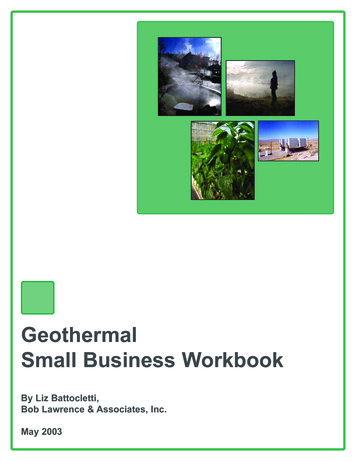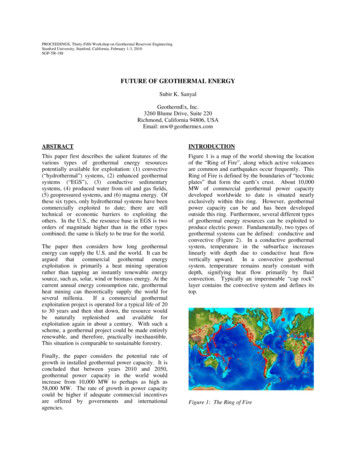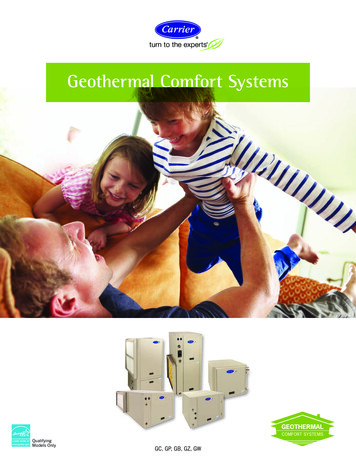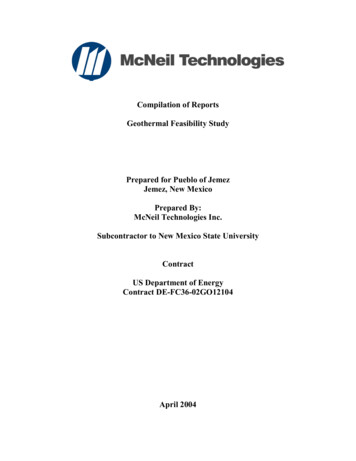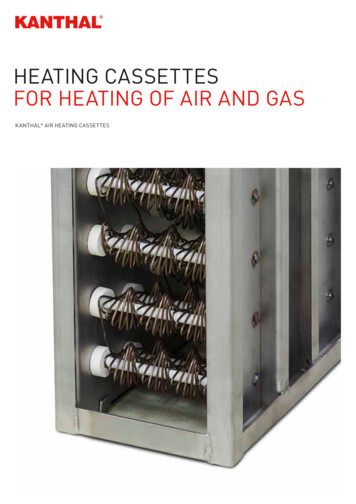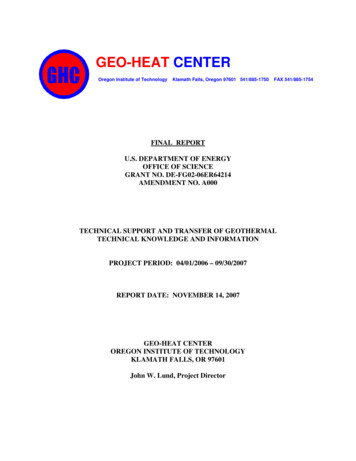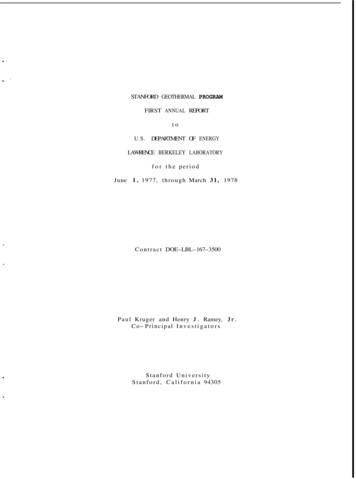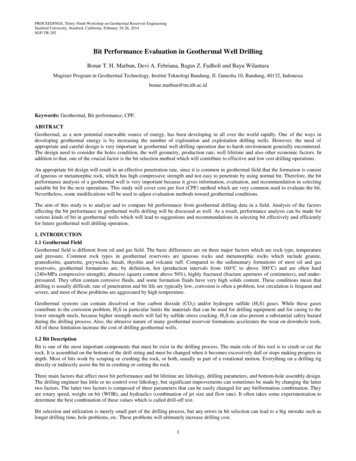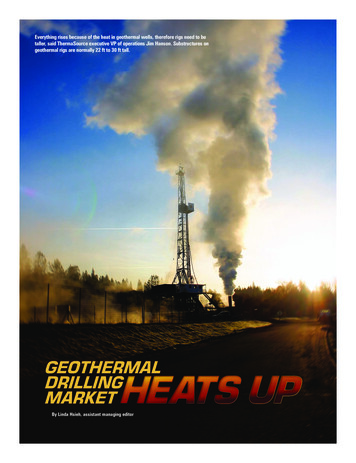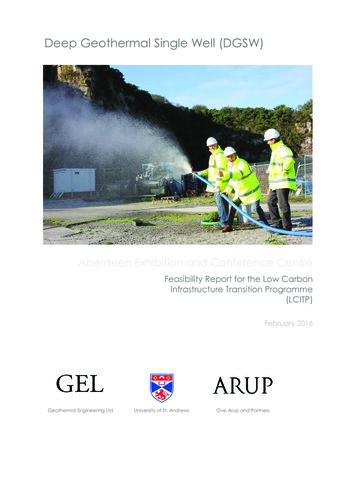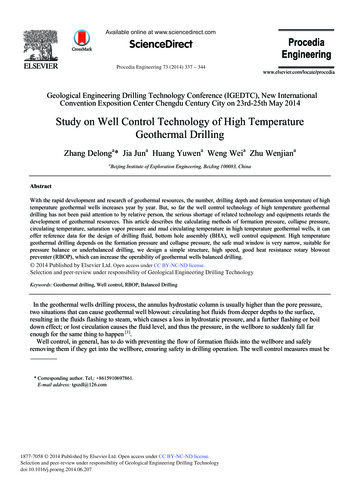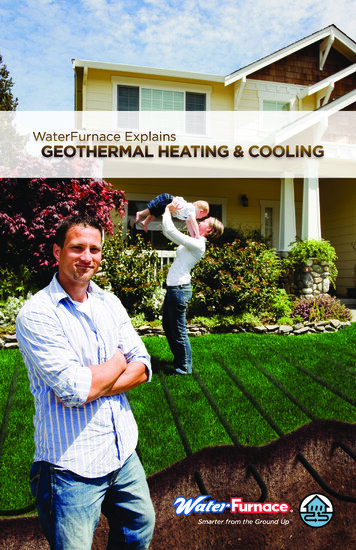
Transcription
WaterFurnace ExplainsGEOTHERMAL HEATING & COOLING
WaterFurnace geothermal heating and cooling systemsuse the clean, renewable energy in your back yard to savehomeowners up to 70% on heating, cooling and hot water.The Environmental Protection Agency and the Departmentof Energy call it “the most cost-effective, energy efficientand environmentally friendly method” of heating andcooling your home available today. This booklet will helpexplain how WaterFurnace can accomplish all this – andhow you can reduce your utility bills today and for manyyears to come.TABLE OF CONTENTSGeothermal Basics. 1Geothermal Heat Pumps . 4In The Loop . 7What Every Owner Should Know . 12Learn More . 15Glossary . 16Conversion Table . 17
GEOTHERMAL HEATING AND COOLING —AN INTRODUCTIONGeothermal heating and cooling is in step with the times – and withthe future. “Green” technologies – which work with the environmentinstead of against it – continue to gain momentum amid concerns overthe skyrocketing cost of fossil fuels and energy conservation.Geothermal technology is proven, reliable and safe. It significantlyreduces energy usage and utility bills for homeowners and businessowners. Millions of geothermal systems are currently saving money andprotecting the environment in all 50 states and around the world.We’ve prepared this booklet to answer questions about how geothermalsystems work and how you can benefit from going geothermal.For more information visit waterfurnace.com.GEOTHERMAL BASICSHow does a geothermal heating and cooling system work? Outdoortemperatures fluctuate with the changing seasons but undergroundtemperatures don’t. Four to six feet below the earth’s surface,temperatures remain relatively constant year-round. A geothermalsystem capitalizes on these constant temperatures to provide “free”energy. In winter, a series of fluid-filled underground pipes called a“loop” absorbs stored heat and carries it indoors. The indoor unitcompresses the heat to a higher temperature and distributes itthroughout the building. In summer, the system reverses, pulling heatfrom the building, carrying it through the earth loop and depositing itin the cooler earth.GEOTHERMAL HEATING AND COOLING — AN INTRODUCTION1
WHAT MAKES A GEOTHERMAL SYSTEMDIFFERENT FROM ORDINARY SYSTEMS?Unlike ordinary systems, geothermal systems don’t burn fossil fuelto generate heat; they simply transfer heat to and from the earthto provide a more efficient, affordable and environmentally friendlymethod of heating and cooling. Typically, only a small amount ofelectricity is used to operate the unit’s fan, compressor and pump.WHAT ARE THE COMPONENTS OF AGEOTHERMAL SYSTEM?The three main parts consist of the geothermal unit, the undergroundpiping system (open or closed loop), and the ductwork.HOW EFFICIENT IS A GEOTHERMAL SYSTEM?A geothermal system is over five times more efficient in heating andmore than twice as efficient in cooling as the most efficient ordinarysystem. Because geothermal systems move existing heat ratherthan creating it through combustion, they provide four to five units ofenergy for every one unit used to power the system.HOW IS EFFICIENCY RATED FOR GEOTHERMAL?All heating and cooling systems have a rated efficiency from a U.S.governmental agency. Fossil fuel furnaces use AFUE. Air conditionersuse SEER while heat pumps use HSPF and SEER.Geothermal heat pumps rate heating efficiencies according to theircoefficient of performance or COP. It’s a scientific way of determininghow much energy the system produces versus how much it uses. Mostgeothermal heat pump systems have COPs of 3-4.5. The WaterFurnace7 Series 700A11 holds certified performances of 5.6 COP in anopen loop and 5.1 in a closed loop. That means for every dollarof energy used to power the system, 5.6 or 5.10 of energy aresupplied as heat. Where a fossil fuel furnace may be 78-98% efficient, ageothermal heat pump is over 500% efficient.2GEOTHERMAL HEATING AND COOLING — AN INTRODUCTION
For cooling, geothermal units are rated by Energy Efficiency Ratio(EER). EER is a measure of efficiency in the cooling mode whenmeasured at a constant temperature (95 F). The higher the EER,the more efficient the unit. The WaterFurnace 7 Series holds certifiedperformance of 43.5 EER for closed loop and 56.0 for open loop.DO GEOTHERMALSYSTEMS REQUIRE MUCHMAINTENANCE?No. Geothermal systems are practicallymaintenance free. The buried loop will lastfor generations. The unit’s fan, compressorand pump is housed indoors, protectedfrom the weather and contamination.Usually, periodic checks and filter changesare the only required maintenance.While WaterFurnace does offer an outdoorgeothermal unit for jobs where spaceis limited, its rugged housing is sealedso that no components are exposed tothe elements.GEOTHERMAL HEATING AND COOLING — AN INTRODUCTION3
GEOTHERMAL HEAT PUMPSWHAT DOES GEOTHERMAL MEAN FORTHE ENVIRONMENT?Geothermal systems work with nature, not against it. They emitno greenhouse gases - which have been linked to pollution, acidrain and other environmental hazards. WaterFurnace’s earth-loopantifreeze will not harm the environment in the unlikely event of aleak. And all of the current WaterFurnace product lines use R-410Aor R134a, both of which are performance-enhancing refrigerantsthat will not harm the earth’s ozone layer.ARE ALL GEOTHERMAL HEAT PUMPS ALIKE?No. There are different kinds of geothermal heat pumps designedfor specific applications. Many geothermal heat pumps, for example,are intended for use only with higher temperature ground waterencountered in open-loop systems. Others will operate at enteringwater temperatures as low as 25 F, which are possible in closedloop systems. Most geothermal heat pumps provide summer airconditioning, but a few brands are designed only for winter heating.Geothermal heat pumps also can differ in the way they are designed.Self-contained units combine the blower, compressor, heat exchangerand coil in a single cabinet. Split systems (such as the WaterFurnaceEnvision Series Split) allow the coil to be added to a forced-air furnaceand utilize the existing blower.HOW DOES A GEOTHERMAL HEAT PUMP WORK?Heat pumps don’t create heat. They take existing heat and move it.Anyone with a refrigerator has witnessed the operation of a heatpump. Refrigerators collect heat from the unit’s interior and move itto the exterior for cooling purposes. Unlike a refrigerator, a heat pumpcan reverse itself. An air-source heat pump, for example, can extractheat from outdoor air and pump it indoors for heating purposes.A geothermal heat pump works the same way, except that itsheat source is the warmth of the earth. The process of elevating4GEOTHERMAL HEAT PUMPS
low-temperature heat to over 100 F and transferring it indoorsinvolves a cycle of evaporation, compression, condensation andexpansion. A refrigerant is used as the heat-transfer mediumwhich circulates within the heat pump. The cycle starts as the cold,liquid refrigerant passes through a heat exchanger (evaporator)and absorbs heat from the low-temperature source (fluid from theground loop). The refrigerant evaporates into a gas as heat is absorbed.The gaseous refrigerant then passes through a compressor wherethe refrigerant is pressurized, raising its temperature to more than180 F. The hot gas then circulates through a refrigerant-to-air heatexchanger where heat is removed and pumped into the building atabout 100 F. When it loses the heat, the refrigerant changes backto a liquid. The liquid is cooled as it passes through an expansionvalve and begins the process again. To work as an air conditioner, thesystem’s flow is reversed.DOES A GEOTHERMALSYSTEM HEAT AND COOL?One thing that makes a geothermal heatpump so versatile is its ability to be aheating and cooling system in one. Witha simple flip of a switch on your indoorthermostat, you can change from onemode to another. In the cooling mode, ageothermal heat pump takes heat fromindoors and transfers it to the coolerearth through either groundwater or anunderground earth loop system. In theheating mode, the process is reversed.GEOTHERMAL HEAT PUMPS5
CAN A GEOTHERMALSYSTEM ALSO HEATWATER?Yes. Some geothermal heat pumpscan provide all of your hot waterneeds at the same high efficienciesas the heating/cooling cycles. Anoption called a hot water assist canbe added to most heat pumps. Itwill provide significant savingsby heating water before it entersyour hot water tank.6GEOTHERMAL HEAT PUMPS
IN THE LOOPDO I NEED SEPARATE EARTH LOOPS FORHEATING AND COOLING?No. The same loop works for both. To switch heating to coolingor vice versa, the flow of heat is simply reversed.DOES THE UNDERGROUND PIPE SYSTEMREALLY WORK?The buried pipe, or earth loop, was an important technical advancementin heat pump technology. The idea of burying pipe in the groundto gather heat energy originated in the 1940’s. New heat pumpdesigns and more durable pipe materials have been combined tomake geothermal heat pumps the most efficient heating and coolingsystems available.WHAT TYPES OF LOOPS ARE AVAILABLE?There are two main types: open and closed.WHAT IS AN OPEN LOOP SYSTEM?An open loop system uses groundwater from an ordinary well as a heatsource. The groundwater is pumped into the heat pump unit whereheat is extracted and the water is disposed of in an environmentallysafe manner. Because groundwater is a relatively constant temperatureyear-round, wells are an excellent heat source.HOW MUCH WATER FLOW DOES AN OPEN LOOPSYSTEM REQUIRE?The water requirement of a specific model is usually expressedin gallons per minute (gpm) and is listed in the unit’s specifications.Generally, the average system will use 1.5 gpm per ton of capacitywhile operating, but the amount of water required depends on theIN THE LOOP7
size of the unit and the manufacturer’s specifications. Your contractorshould be able to provide this information. Your well and pumpcombination should be large enough to supply the water needed bythe heat pump in addition to your domestic water requirements. You’llprobably need to enlarge your pressure tank or modify your plumbingto supply adequate water to the heat pump.WHAT DO I DO WITH THE DISCHARGE WATER?There are a number of ways to dispose of water after it has passedthrough the heat pump. The open discharge method is the easiest andleast expensive. Open discharge simply involves releasing the waterinto a stream, river, lake, pond, ditch or drainage tile. Obviously, oneof these alternatives must be readily available and have the capacityto accept the amount of water used by the heat pump before opendischarge is feasible.A second means of water discharge is the return well. A return wellis a second well bore that returns the water to the ground aquifer. Areturn well must have enough capacity to dispose of the water passedthrough the heat pump. A new return well should be installed by aqualified well driller. Likewise, a professional should test the capacity ofan existing well before it is used as a return.ARE THERE ANY LAWS THAT APPLY TO OPENLOOP INSTALLATIONS?All or part of the installation may be subject to local ordinances, codes,covenants or licensing requirements. Check with local authorities todetermine if any restrictions apply in your area.DOES AN OPEN LOOP SYSTEM CAUSEENVIRONMENTAL DAMAGE?No. They are pollution free. The heat pump merely removes or addsheat to the water. No pollutants are added. The only change in thewater returned to the environment is a slight increase or decreasein temperature.8IN THE LOOP
WHAT PROBLEMS CAN BE CAUSED BY POORWATER QUALITY?Poor water quality can cause serious problems in open loop systems.Your water should be tested for hardness, acidity and iron content beforea heat pump is installed. Your contractor or equipment manufacturer cantell you what level of water is acceptable. Mineral deposits can build upinside the heat pump’s heat exchanger. Sometimes a periodic cleaningwith a mild acid solution is all that’s needed to remove the build-up.Impurities, particularly iron, can eventually clog a return well. If yourwater has high iron content, make sure that the discharge water is notaerated before it’s injected into a return well.IN THE LOOP9
WHAT IS A CLOSED LOOP SYSTEM?A closed loop system uses a continuous loop of buried polyethylenepipe. The pipe is connected to the indoor heat pump to form a sealed,underground loop through which an environmentally friendly antifreezeand-water solution is circulated. A closed loop system constantlyrecirculates its heat-transferring solution in pressurized pipe, unlike anopen loop system that consumes water from a well. Most closed loopsare trenched horizontally in areas adjacent to the building. However,where adequate land is not available, loops are vertically bored. Anyarea near a home or business with appropriate soil conditions andadequate square footage will work.HOW LONG WILL THE LOOP PIPE LAST?Closed loop systems should be installed using only high-densitypolyethylene pipe. Properly installed, these pipes can outlast thehouse. They are inert to chemicals normally found in soil and havegood heat conducting properties. PVC pipe should never be used.HOW DEEP OR LONG WILL MY TRENCHES BE?Trenches are normally four to six feet deep and up to 400 feet long,depending on the number of pipes in a trench. One advantage ofa horizontal loop system is being able to lay the trenches accordingto the shape of the land. As a rule of thumb, 500-600 feet of pipe isrequired per ton of system capacity. A well-insulated 2,000 squarefoot home would need about a three-ton system with 1,500 - 1,800feet of pipe. Loop lengths and depths may vary with loop type, soilconditions and climate.HOW ARE THE PIPE SECTIONS OF THELOOP JOINED?Pipe sections are joined by thermal fusion. Thermal fusion involvesheating the pipe connections and then fusing them together to forma joint that’s stronger than the original pipe. This technique creates asecure connection to protect from leakage and contamination.10IN THE LOOP
I HAVE A POND NEARBY. CAN I PUT A LOOP IN IT?Yes, if it’s deep enough and large enough. A minimum of six feet in depthat its lowest level during the year is needed for a pond to be considered.The amount of surface area required depends on the heating andcooling load of the structure. You should opt against using water froma spring, pond, lake or river as a source for an open loop system unlessit’s proven to be free of excessive particles and organic matter. Theycan clog a heat pump system and make it inoperable in a short time.CAN I INSTALL AN EARTH LOOP MYSELF?It’s not recommended. Good earth-to-coil contact is very importantfor successful loop operation. Nonprofessional installations may resultin inefficient system performance.WHAT IF I DON’T HAVE ENOUGH ROOM FOR AHORIZONTAL LOOP?Closed loop systems also can be vertical. Holes are bored up to 250 feetper ton of heat pump capacity, depending on where you live. U-shapedloops of pipe are inserted in the holes. The holes are then grouted frombottom to top to ensure consistent ground contact with the earth.VERTICAL LOOPIN THE LOOPHORIZONTAL LOOPPOND LOOP11
WHAT EVERY OWNER SHOULD KNOWHOW DO I KNOW IF THE DEALER AND LOOPINSTALLERS ARE QUALIFIED?Don’t be afraid to ask for references from dealers. A reputable dealeror loop installer won’t hesitate to give you names and numbers to callto confirm his capabilities.CAN A GEOTHERMAL HEAT PUMP BE ADDED TOMY FOSSIL FUEL FURNACE?Split systems can easily be added to existing furnaces for thosewishing to have a dual-fuel heating system. Dual-fuel systems use theheat pump as the main heating source and a fossil fuel furnace as asupplement in extremely cold weather if additional heat is needed.IS A GEOTHERMAL HEAT PUMP DIFFICULTTO INSTALL?Most units are easy to install, particularly when they replace anotherforced-air system. They can be installed in areas unsuitable for fossilfuel furnaces because there is no combustion, thus no need to ventexhaust gases. Ductwork must be installed in homes that don’t havean existing air distribution system. The difficulty of installing ductworkwill vary and should be assessed by a contractor. Another popular wayto use geothermal technology is with in-floor radiant heating, in whichhot water circulating through pipes under the floor heats the room.I HAVE DUCTWORK, BUT WILL IT WORK WITHTHIS SYSTEM?In all probability, yes. Your installing contractor should be able to determineductwork requirements and any minor modifications if needed.12WHAT EVERY OWNER SHOULD KNOW
IF A HOME HAS CEILING CABLE HEAT ORBASEBOARD HEAT, DO AIR DUCTS NEED TOBE INSTALLED?Not always. It may be desirable to install geothermal heat pumproom units. For some small homes, a one-room unit would handle theheating and cooling needs. Ceiling cable or baseboard units could beused for supplemental heat if desired.DO I NEED TO INCREASE THE SIZE OF MYELECTRIC SERVICE?Geothermal heat pumps don’t use large amounts of resistance heat soyour existing service may be adequate. Generally, a 200-amp servicewill have enough capacity, and smaller amp services may be largeenough in some cases. Your electric utility or contractor can determineyour service needs.WHAT IS THE BTU SIZE OF THE FURNACE THAT’SBEING PROPOSED?Furnaces are designed to provide specific amounts of heat energy perhour. The term “BTUH” refers to how much heat can be produced bythe unit in an hour. Before you can determine what size furnace you’llneed, you must have a heat loss/heat gain calculation done on thestructure. From that, an accurate determination can be made of thesize of the system you’ll need. Most fossil fuel furnaces are substantiallyoversized for heating requirements, resulting in increased operatingcost and unpleasant temperature swings.WHAT EVERY OWNER SHOULD KNOW13
SHOULD I BUY A GEOTHERMAL HEATPUMP LARGE ENOUGH TO HEAT WITH NOSUPPLEMENTAL HEAT?Your contractor should provide a heating and cooling load calculation(heat loss, heat gain) to guide your equipment selection. Geothermalheat pumps typically are sized to meet your cooling requirements.Depending on your heating needs, a geothermal heat pump will supply80-100 percent of your heating load. Sizing the heat pump to handleyour entire heating needs may result in slightly lower heating costs,but the savings may not offset the added cost of the larger heat pumpunit and larger loop installation. Also, an oversized unit can causedehumidification problems in the cooling mode, resulting in a loss ofsummer comfort.HOW LONG IS THE PAYBACK PERIOD FOR AGEOTHERMAL SYSTEM?Geo thermal systems are so energy-efficient that the payback periodis remarkably brief. A study by the Air Force Institute of Technologycalculated that it takes on average just seven to eight years torecoup costs.Your specific payback point depends on factors like local utilityrates, excavation/drilling costs, how well your house is insulated, theefficiency of the model you choose, and what incentives your state orutilities provide.One of the best aspects about geothermal is cash flow. If you install ageothermal system, the monthly savings in operating costs generallyoffset the additional monthly financing cost, resulting in an immediatepositive cash flow - especially in a new home. Again, your specificsituation may vary.14WHAT EVERY OWNER SHOULD KNOW
LEARN MOREHOW CAN I LEARN MORE ABOUT GEOTHERMALSYSTEMS?Visit our website at waterfurnace.com. Our comprehensive site offers awide variety of information on geothermal technology, our latest productsand the latest news. It also will help you find an independent WaterFurnacedealer in your area. Most electric utilities have information aboutgeothermal systems. Get in touch with the experts and start saving onyour utility bills right away!LEARN MORE15
GLOSSARYBTU (BRITISH THERMAL UNIT): The amount of heat needed to raisethe temperature of one pound of water one degree Fahrenheit. Btu isused to signify the heating and cooling capacity of a system and theheat losses and gains of buildings and homes.BTUH: The number of BTUs produced in one hour.CLOSED LOOP SYSTEM: A heat pump system that uses a loop ofburied pipe as a heat exchanger. Loops can be horizontal or vertical.COP (COEFFICIENT OF PERFORMANCE): The ratio of heatingprovided by a heat pump to the energy consumed by the systemunder designated operating conditions. The higher the COP, the moreefficient the system.COMPRESSOR: The central part of a heat pump system. The compressorincreases the pressure and temperature of the refrigerant andsimultaneously reduces its volume while causing the refrigerant tomove through the system.CONDENSER: A heat exchanger in which hot, pressurized (gaseous)refrigerant is condensed by transferring heat to cooler surrounding air,water or earth.CYCLING LOSSES: The efficiency of a heating or cooling system isreduced due to start-up and shut-down losses. Over-sizing a heatingor cooling system increases cycling losses.EVAPORATOR: A heat exchanger in which cold, liquid refrigerantabsorbs heat from the low-temperature source (fluid from theground loop).FOSSIL FUEL: Combustible fuels formed from the decomposition oforganic matter. Examples are natural gas, propane, fuel oil, and coal.GEOTHERMAL HEAT PUMP: A heat pump that uses the earth as a heatsource and heat sink.HEAT EXCHANGER: A device designed to transfer heat betweentwo physically separated fluids or mediums of different temperatures.16GLOSSARY
HEAT PUMP: A mechanical device used for heating and cooling whichoperates by pumping heat from a cooler to a warmer location. Heatpumps can extract heat from air, water, or the earth. They are classifiedas either air-source or geothermal units.HEAT SINK: The medium – air, water or earth – which receives heatrejected from a heat pump.HEAT SOURCE: The medium – air, water or earth – from which heat isextracted by a heat pump.HOT WATER ASSIST: A device for recovering superheat from thecompressor discharge gas of a heat pump or central air conditioner foruse in heating or preheating water.OPEN LOOP SYSTEM: A heat pump system that uses groundwaterfrom a well or surface water from a lake, pond, or river as a heat source.The water is returned to the environment.PAYBACK: A method of calculating how long it will take to recoverthe difference in costs between two different heating and coolingsystems by using the energy and operating cost savings from themore efficient system.SUPPLEMENTAL HEATING: A heating system used during extremelycold weather when additional heat is needed to moderate indoortemperatures. May be in the form of fossil fuel or electric resistance.CONVERSION TABLEU.S.GLOSSARY(EQUALS)CANADIAN1 GALLON .8 GALLON (3.78 LITERS)1 FOOT .304 METER1,000 FEET 304.8 METERS1 BTU 252 CALORIES (GRAMS)FAHRENHEIT CELSIUS (F - 32) X 5/9(EXAMPLE: 40 F) (4.44 C)17
WHY CHOOSE WATERFURNACE?WaterFurnace is the most recognized and respected name in geothermal.That’s because we’ve lead the industry in design, efficiency, reliability andwarranty protection for over 35 years. We’re also home of some of themost efficient heating and cooling systems ever certified by AHRI.WaterFurnace is dedicated to providing you with safe, reliable andenergy-efficient heating and cooling systems that save you money whilehelping protect our environment. Our engineers and technicians work tocreate and build quality geothermal products that are extensively testedto ensure the highest quality. An industry leader and an innovator ingeothermal technology—WaterFurnace. Smarter from the Ground Up.waterfurnace.comPrinted with 10% post-consumer waste recycled paperBR1521MW 03/21 2021 WaterFurnace International, Inc., 9000 Conservation Way, Fort Wayne, IN 46809-9794. WaterFurnacehas a policy of continuous product research and development, and reserves the right to change designand specifications without notice.
how much energy the system produces versus how much it uses. Most geothermal heat pump systems have COPs of 3-4.5. The WaterFurnace 7 Series 700A11 holds certified performances of 5.6 COP in an open loop and 5.1 in a closed loop. That means for every dollar of energy used to power the system, 5.6 or 5.10 of energy are supplied as heat.
